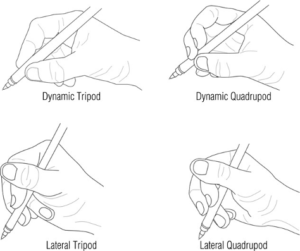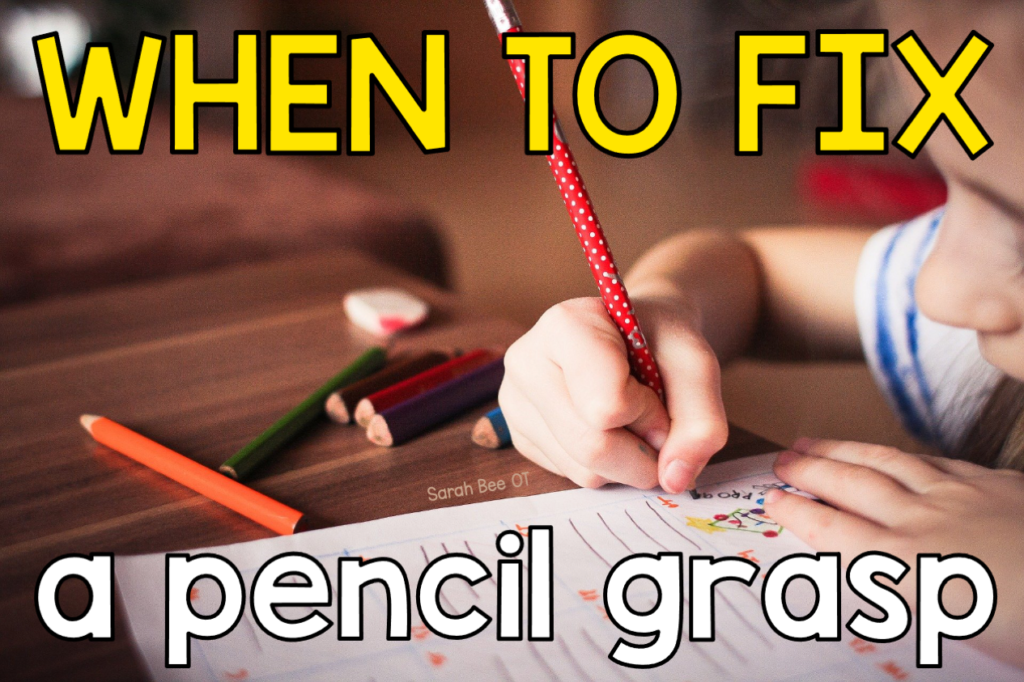One of the most common things I get asked about as a pediatric occupational therapist in the school-based setting is pencil grasp.
“What is the most functional pencil grasp?”
“When do I try to change a student’s pencil grasp?”
“Did you SEE how so-and-so was holding their pencil?!”
It’s a hot button issue. Atypical grasp patterns can illicit quite a strong response from parents, educators and OT practitioners alike. But how do you know whether you should encourage a more “traditional” grasp or just leave it be?
Does pencil grasp really matter? Well, it depends.
Let’s have a quick chat about mature grasp patterns. For a long time now, the “textbook” example for a mature pencil grasp has been the dynamic tripod grasp. The term tripod refers to the number of fingers (three) that grasp the utensil, and the term dynamic refers to the use of small finger movements to control the utensil.
While the dynamic tripod grasp is known for being the “gold standard” for pencil grasps, there are actually 3 other mature grasp patterns that are just as desirable.

Research shows that the quadrupod, lateral tripod, and lateral quadrupod grasps are equally as effective as the tripod.
Studies that looked at the relationship between pencil grasp and writing efficiency have found no significant differences in writing legibility or speed when comparing all four grasps to one another (Dennis & Swinth, 2001; Koziatek & Powell, 2003; Schwellnus et al., 2012; Schwellnus et al., 2013). This informs us that if a school-aged child is demonstrating any of the above grasp patterns, we should leave it be.
But research about atypical grasp patterns and their relationship to writing performance is seriously lacking.
There are no studies that thoroughly compare the writing performance of students who use one of the four mature grasp patterns versus those who are using immature or atypical grasp patterns.
- An immature grasp refers to a grasp that occurs naturally during the developmental process, but is delayed for a child’s age. For a school-aged child, examples of an immature grasp would be palmar supinate or digital pronate grasp.
- An atypical grasp pattern is one that doesn’t quite follow the “norm” or the typical developmental progression. This might include an interdigital grasp, thumb-tuck grasp, or what I’ve been referring to on Instagram as “the claw”.
Let me be absolutely clear about something though-
Just because it isn’t pretty or “age appropriate”, does NOT mean it isn’t functional!
A more mature grasp does not equate to perfect function, much like an atypical grasp does not automatically equal dysfunction. There are plenty of people out there who may have the funkiest looking pencil grasp, but it is 100% functional for what they need to do in their day-to-day life.
It is only when I see dysfunction paired with atypical or immature grasp patterns, that I will step in to try and intervene.
Here are the top 5 things I consider when it comes to a child’s pencil grasp:
Age
Is the child at an age where developmentally they are still working on acquiring a mature pencil grasp, or are they of an age where the pencil grasp is already well established? Most children begin to develop a mature (dynamic) tripod grasp between the ages of 4-6 years old. Once a child moves beyond 1st grade, pencil grasp can be difficult to change unless the child is intrinsically motivated to do so. It is more difficult to change an established grasp pattern than it is to facilitate the development of one from the beginning. So from 2nd grade and beyond, I recommend focusing on accommodations to promote better functioning rather than trying to change the pencil grasp. Prior to school age, I recommend engaging children in activities to support the development of a mature grasp pattern, such as coloring with broken crayon pieces.
Pain
Is the pencil grasp causing the child pain while writing or drawing? Some atypical grasp patterns may include awkward finger positioning that results in pain as the activity progresses. Additionally, some children present with hypermobility, which causes hyperextension at the joints in their fingers that may result in pain over time. If a pencil grasp is painful, it is not functional.
Fatigue
Does the child tend to fatigue quickly during pencil tasks? Atypical or immature grasp patterns may rely on movement from the whole arm or wrist to drive the utensil, rather than movements from the small muscles of the hand. The use of these extrinsic muscles- versus the intrinsic muscles that are utilized with mature grasp patterns- can lead to early fatigue while writing.
Control
Is the child able to adequately control their pencil? Does their finger placement on the utensil allow them to write without excess slipping or fumbling? Atypical or immature grasp patterns can reduce a child’s ability to use fine distal movements of their fingers to control the pencil, which can result in decreased accuracy with precision tasks. A functional pencil grasp should facilitate dynamic movement of the fingers in varying directions (up/down, side to side, diagonally, and in circular motions). This controlled movement is needed during tasks like handwriting, and without it, a child may have difficulty forming and sizing letters with precision.
Speed
Is the child writing at a pace similar to their peers? Are they able to keep up with the demands of their classwork, or do they tend to fall behind? While cognitive factors might also be at play here, an ineffective pencil grasp can contribute to deficits with writing speed. These difficulties can be secondary to pain or fatigue resulting in the need for frequent breaks, or from decreased fine motor control that results in slow, laborious formation of letters while writing.
So, when examining what may be causing a child’s difficulty with writing, I consider all of these factors and then some.
Pencil grasp alone is not the end-all, be-all of writing performance. It’s important to identify any other underlying issues that may be impacting a child’s performance, such as their hand strength, dexterity, proximal stability, motor planning, primitive reflexes, tactile and proprioceptive senses, visual perception, visual motor control. cognition, desk positioning, and so on.
So in the end, when should you fix a child’s pencil grasp?
Answer: When you see atypical grasp patterns paired with dysfunction.
Sincerely,
An occupational therapist with one heck of a thumb wrap grasp
References:
- Dennis, J. L., & Swinth, Y. (2001). Pencil grasp and children’s handwriting legibility during different-length writing tasks. American Journal of Occupational Therapy, 55, 175–183. https://doi.org/10.5014/ajot.55.2.175
- Koziatek, S. M., & Powell, N. J. Pencil grips, legibility, and speed of fourth-graders’ writing in cursive. American Journal of Occupational Therapy, 57, 284–288. https://doi.org/10.5014/ajot.57.3.284
- Schwellnus, H., Carnahan, H., Kushki, A., Polatajko, H., Missiuna, C., & Chau, T. (2012). Effect of pencil grasp on the speed and legibility of handwriting in children. American Journal of Occupational Therapy, 66, 718–726. https://doi.org/10.5014/ajot.2012.004515
- Schwellnus, H., Carnahan, H., Kushki, A., Polatajko, H., Missiuna, C., & Chau, T. (2013). Writing forces associated with four pencil grasp patterns in Grade 4 children. American Journal of Occupational Therapy, 67, 218–227. https://doi.org/10.5014/ajot.2013.005538


“So from 2nd grade and beyond, I recommend focusing on accommodations to promote better functioning rather than trying to change the pencil grasp.”
Hello! When you stated this, what accommodations do you use in treatment?
Hi Stephanie,
It would depend on the child’s age and what the primary concerns are around their functioning! Some accommodations might include soft grips on the pencil for comfort, mechanical pencils to reduce pressure, typing as an alternative, pre-filled notes, etc.
Some students may benefit from use of a pencil grip that adjusts their grasp to something more functional. They might not transfer this grasp pattern to other utensils (e.g., crayons, markers) but it may allow them to better access handwriting tasks in the moment.
Hope that helps!
Sarah
There are actually a few research studies that indicate that grasp patter (mature or immature, typical or atypical) doesn’t impact quality or speed of writing.
https://pubmed.ncbi.nlm.nih.gov/23106992/
https://www.researchgate.net/publication/225299661_Effect_of_pencil_grasp_on_the_speed_and_legibility_of_handwriting_after_a_10-minute_copy_task_in_Grade_4_children
Hi! Thanks for your comment. The studies you mention (cited in my blog post) do not thoroughly explore the impact of immature or atypical grasp patterns on writing function. They primarily look at the four major grasp patterns: tripod, lateral tripod, quadrupod, and lateral quadrupod. The studies do show that there aren’t significant differences between these four types, which tells us that we should not be trying to alter a child’s grasp if they demonstrate one of them.
There is a lack of research about immature or atypical grasp patterns. Until that’s available, we must consider factors such as pain and fatigue when addressing grasp!
Sarah
Hello,
I have a 6.5 year old who still uses a palmer supinate grasp.
I am told he has good handwriting for his age and he has always loved drawing and colouring. However it looks like such an effort for him to write and he tires easily.
Should I be worried? School have tried to help him but had no success.